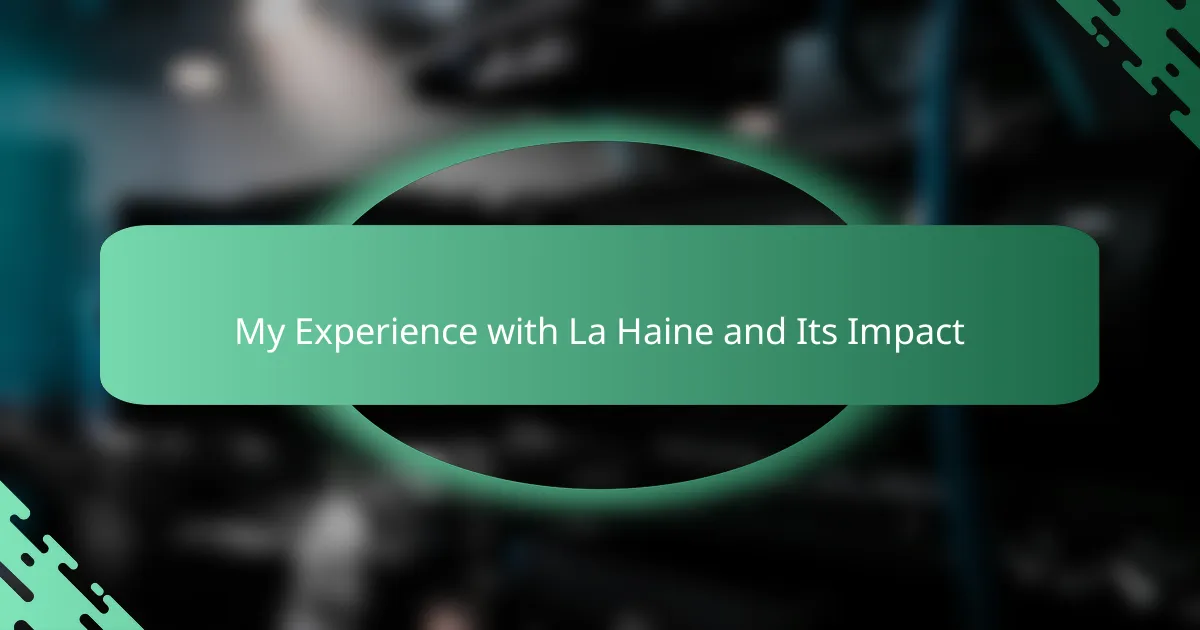Key takeaways
- French cinema, exemplified by films like La Haine, reflects societal issues and emotions, prompting deep cultural reflections.
- La Haine’s portrayal of marginalized youth highlights themes of social inequality, police violence, and the importance of friendship amidst chaos.
- The film has had a lasting societal impact, sparking discussions on race and systemic oppression that continue to resonate today.
- Key lessons from La Haine include the significance of empathy, the cycle of violence, and the role of art in fostering social awareness.
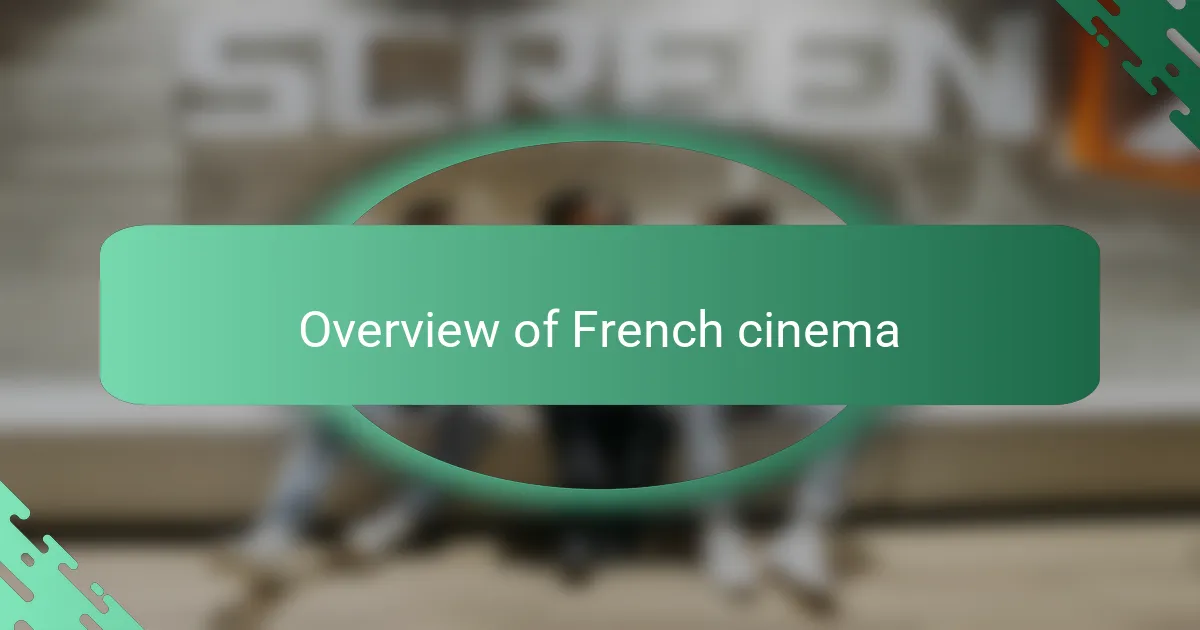
Overview of French Cinema
French cinema is a rich tapestry, woven with diverse narratives and styles that reflect both the complexities and beauty of life. I remember the first time I watched a classic French film; it felt like stepping into a world where every frame spoke volumes. Have you ever felt that deep connection to a story that transcends language?
The French film industry is renowned for its artistic innovation and iconic directors, from the Nouvelle Vague (New Wave) pioneers like François Truffaut and Jean-Luc Godard to contemporary visionaries like Céline Sciamma. Their films often challenge societal norms and provoke thought, making me ponder the intricacies of human relationships and social issues. Isn’t it fascinating how a film can prompt such deep reflection?
Furthermore, French cinema often embraces a unique blend of poetic realism and avant-garde techniques, allowing filmmakers to explore a range of emotions and themes. I’ve found that even the most challenging films can leave a lasting impact, inviting viewers to question their own perspectives. What do you think it is that makes French films resonate so deeply across cultures?
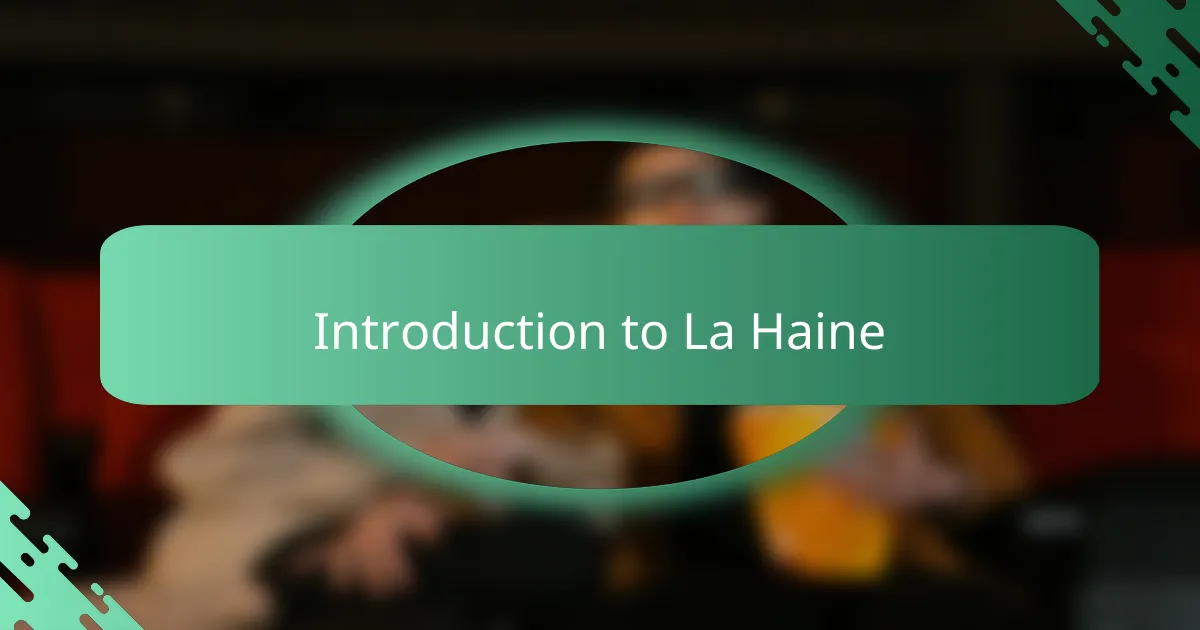
Introduction to La Haine
La Haine, directed by Mathieu Kassovitz, is a poignant film that has left a profound mark on French cinema since its release in 1995. I recall the first time I watched it; the raw intensity of the characters and their struggles resonated deeply with me. It wasn’t just a film; it was a powerful reflection of societal issues, encapsulating the frustrations and anger of marginalized youth in the suburbs of Paris.
The film uniquely captures a 24-hour period in the lives of three friends—Vinz, Saïd, and Hubert—after a riot. The cinematography, shot in stark black and white, enhances its gritty realism, immersing viewers in their chaotic world. I found myself on an emotional rollercoaster, grappling with their pain, anger, and ultimately their hope for change.
- A brief overview of the film’s plot and main characters.
- The significance of the black-and-white cinematography in amplifying the film’s message.
- How La Haine sparked discussions about race, class, and police violence in France.
- Personal reflections on the film’s emotional impact on viewers.
- The cultural context of the 1990s in France that shaped the film’s narrative.
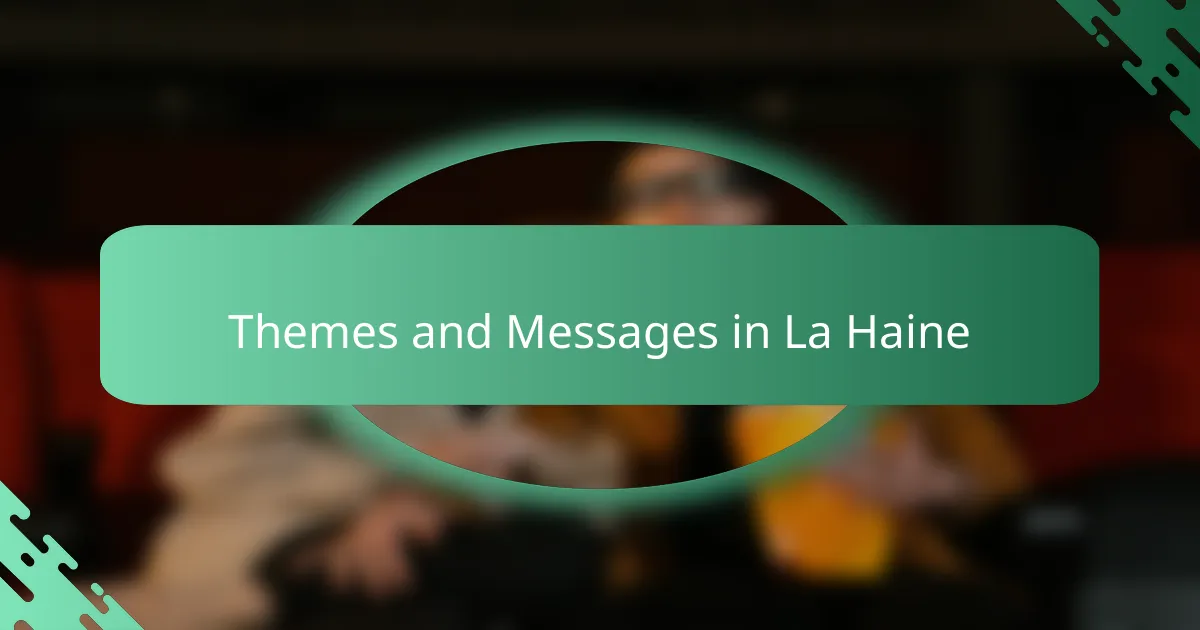
Themes and Messages in La Haine
The themes of La Haine resonate with the raw realities of social inequality and systemic oppression. I can recall feeling a mix of anger and empathy as I watched Vinz, Saïd, and Hubert navigate a world where they felt trapped by their circumstances. Isn’t it striking how the film so powerfully illustrates the cycle of violence and despair that often plagues marginalized communities?
One particularly powerful message is the impact of police brutality and the distrust it breeds between authorities and the youth. I remember being stunned by the realism depicted in the interactions between the characters and law enforcement. It made me question how such strained relationships can escalate into violence, highlighting a crucial issue still relevant today.
Furthermore, the film captures the essence of friendship amid chaos, portraying how bonds can offer solace and support in turbulent times. I found myself reflecting on my own friendships—how they can uplift us in our darkest moments. Hasn’t everyone experienced that feeling of unity when facing the world’s injustices together? These layers of camaraderie, frustration, and hope make La Haine a timeless exploration of the human condition.
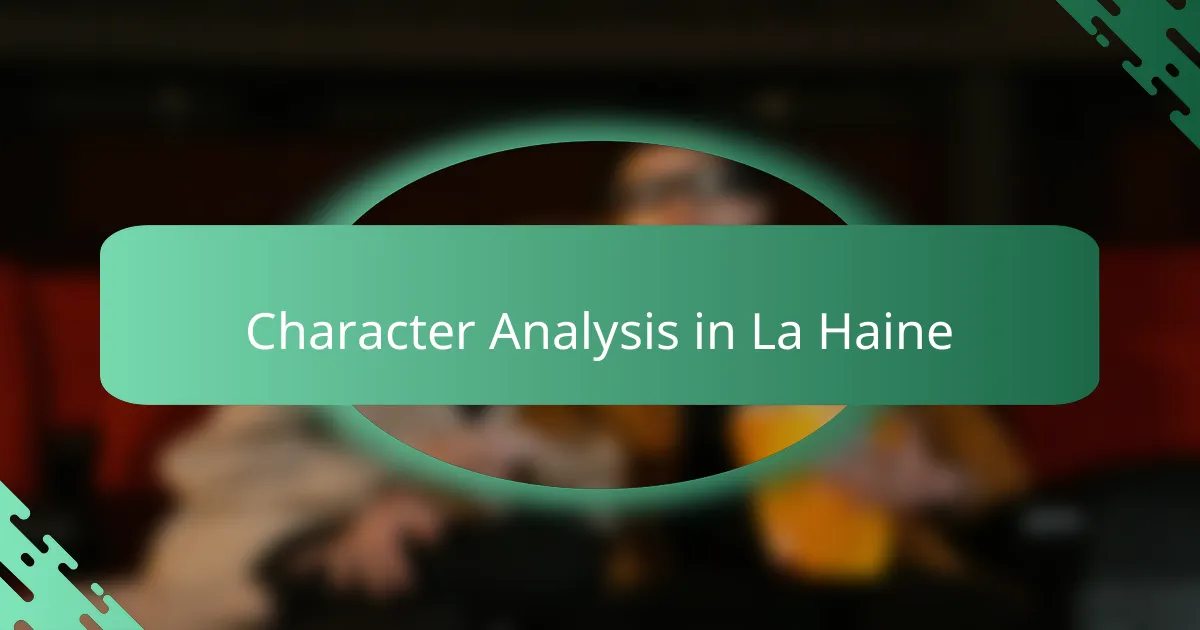
Character Analysis in La Haine
Characters in “La Haine” are the beating heart of the film. Each character represents different aspects of life in the banlieues of France, with their experiences painting a vivid picture of societal struggles. I remember feeling deeply connected to Vinz, whose anger and frustration struck a chord with me; it’s hard to ignore the power of his desire for respect and retaliation.
Hubert embodies a more contemplative approach, grappling with the consequences of violence and the desire for peace. I found myself reflecting on his journey, as he often serves as a voice of reason amidst chaos. Saïd, on the other hand, adds a layer of lightness yet struggles with his identity in a tough environment. His blend of humor and vulnerability made me empathize with his plight.
The dynamics between these three characters highlight the unique ways individuals cope with their reality, prompting the viewer to question their own perceptions of anger, safety, and friendship in challenging circumstances.
| Character | Key Traits |
|---|---|
| Vinz | Angry, impulsive, seeks respect |
| Hubert | Thoughtful, seeks peace, introspective |
| Saïd | Humorous, vulnerable, identity seeker |

My Personal Experience with La Haine
The first time I watched La Haine, I felt an overwhelming sense of urgency wash over me. I distinctly remember the tension hanging thick in the air as the story unfolded. It was as if I had been transported into the heart of the banlieues, witnessing a reality that felt both foreign and painfully familiar. Have you ever watched something so powerful that you couldn’t shake it from your mind for days?
As the film progressed, the characters’ struggles resonated deeply within me. I was particularly struck by Vinz’s fierce determination, which reminded me of my own youthful passion. His desire for respect and recognition mirrored experiences from my own life, making me ponder the lengths we go to find our place in an often unjust world. It’s fascinating how movies can ignite such relatable feelings, isn’t it?
The black-and-white cinematography of La Haine added to its emotional weight. I found myself drawn in, feeling each moment of pain and hope alongside the characters. It made me reflect on how sometimes we have to strip away the colors of life to truly see the rawness of our existence. Don’t you think that this stark portrayal amplifies the urgency of their message?

Impact of La Haine on Society
The impact of La Haine on society is both profound and enduring. When I think about its release in 1995, I recognize how it sparked crucial conversations about race and police violence in France’s suburbs. It made viewers like me confront uncomfortable truths about societal inequalities that often go unnoticed. Have you ever had a film ignite a discussion that changed how you see the world?
The film highlighted the frustration and anger of marginalized youth, shining a spotlight on issues that resonated deeply with not just French society, but with audiences globally. I remember discussing the film with friends, and it was fascinating to see how it prompted us to reflect on our own experiences with authority and community. Isn’t it amazing how a piece of art can bridge gaps and inspire collective understanding?
Moreover, La Haine’s influence extends beyond the screen, inspiring protests and social movements that echo its themes. I often reflect on how its raw portrayal of urban life still finds relevance today, teaching us that the fight against systemic oppression is far from over. Isn’t it thought-provoking that even after decades, the conversations it started continue to shape our society?
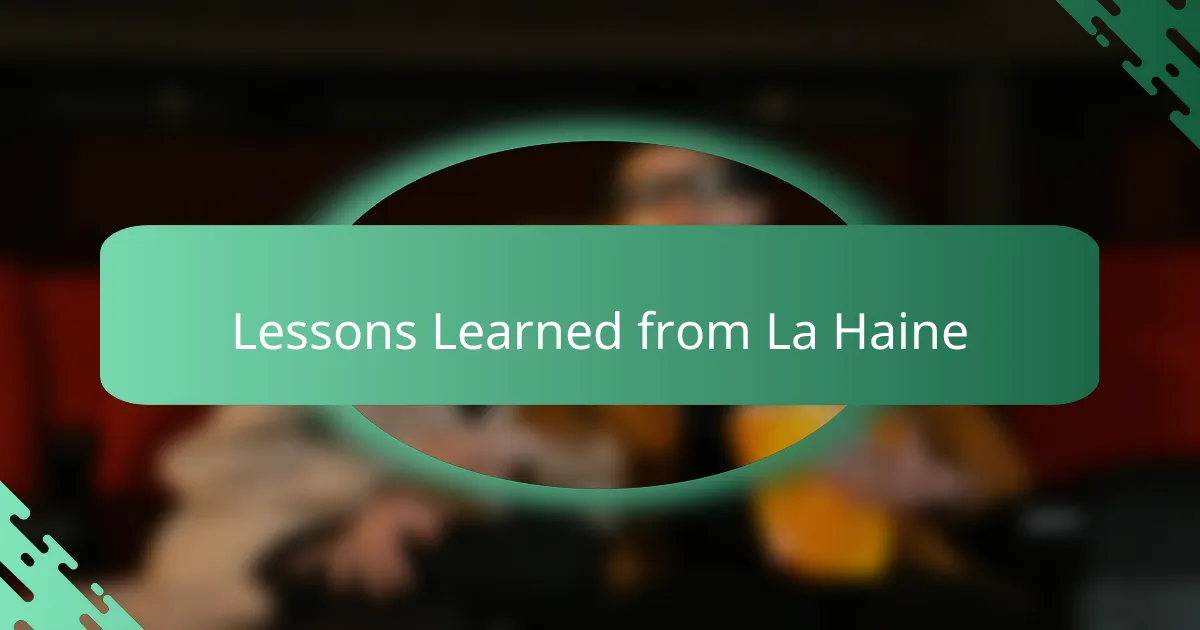
Lessons Learned from La Haine
One of the most profound lessons I took away from “La Haine” is the importance of understanding perspectives. The film unravels the emotional turmoil of its characters, reminding me of my own experiences with societal tensions. I recall a moment after watching the film, feeling compelled to engage in discussions about social injustice, drawing parallels with issues in my community.
Moreover, “La Haine” emphasizes the cycle of violence and how it perpetuates suffering. I remember feeling a weight in my chest, reflecting on instances where anger had overshadowed reason in my own life. This film taught me that breaking this cycle requires empathy and dialogue, rather than retaliation.
- Empathy can bridge divides and foster understanding.
- Violence often begets more violence; seeking peaceful solutions is crucial.
- Recognizing systemic issues is the first step to making change.
- Real connections with others can lead to transformative dialogues.
- Art can be a powerful catalyst for social awareness and reflection.
